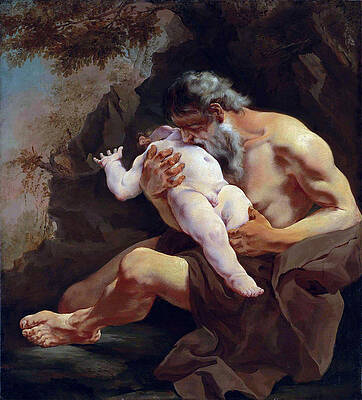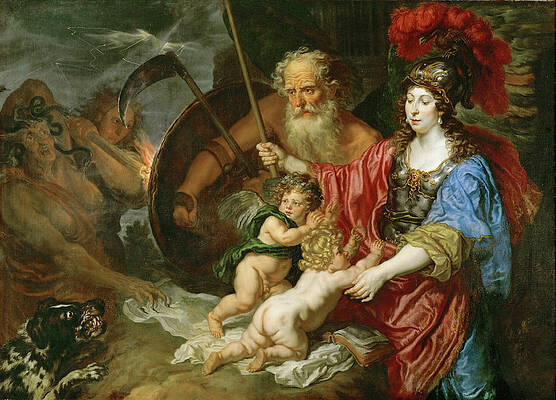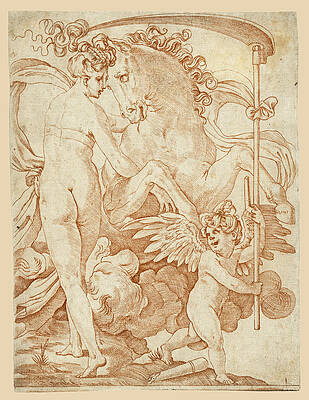.
Cronus (of obscure etymology, perhaps related to "horned"), also spelled Cronos or Kronos (Κρόνος), is often confused with Chronos/Khronos. In Greek mythology, Cronus was the leader and (in some myths) the youngest of the first generation of Titans. His mother was Gaia, and his father was Uranus, whom Cronus envied. Uranus hid the youngest children of Gaia, the one-hundred armed giants (Hecatonchires) and the one-eyed giants, the Cyclopes, in Tartarus so that they would not see the light, rejoicing in this evil doing. This caused pain to Gaia (Tartarus was her bowels), so she created grey flint and shaped a great sickle and gathered together Cronus and his brothers to ask them to obey her. Only Cronus was willing to do the deed, so Gaia gave him the sickle and set him in ambush. Cronus jumped out and lopped off his father's testicles, casting them behind him. From his blood on the Earth came forth the Gigantes, Erinyes, and Meliae. From the testicles of Uranus in the sea came forth Aphrodite. For this, Uranus called his sons Titans, meaning "strainers," for they strained and did presumptuously a fearful deed, for which vengeance would come afterwards.
Cronus was identified in antiquity with the God Saturn of Roman mythology.
In an alternate version, a more benevolent Cronus overthrew the wicked serpentine Titan, Ophion. In doing so he released the world from bondage and for a time ruled it justly.
After dispatching Uranus, Cronus re-imprisoned the Hecatonchires, the Gigantes, and the Cyclopes and set the monster Campe to guard them. He and Rhea took the throne as King and Queen of the gods. This time was called the Golden Age, as the people of the time had no need for laws or rules; everyone did right, so there was no need.
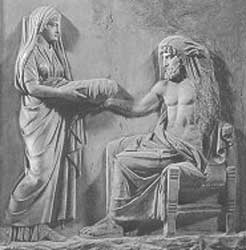
Rhea gives to Cronus a rock wrapped in clothes.
Cronus sired several children by Rhea: Demeter, Hera, Hades, Hestia, and Poseidon, but swallowed them all as soon as they were born, since he had learned from Gaia and Uranus that he was destined to be overcome by his own son as he had overthrown his own father. But when Zeus was about to be born, Rhea sought Uranus and Earth to devise a plan to save him, so that Cronus would get his retribution for his acts against Uranus and his own children. Rhea gave birth to Zeus in Crete, handing Cronus a stone wrapped in swaddling clothes which he promptly swallowed.
Then she hid Zeus in a cave on Mount Ida in Crete. According to varying versions of the story:
He was then raised by Gaia.
He was raised by a goat named Amalthea, while a company of Kouretes, soldiers, or smaller gods danced, shouted, and clapped their hands to make noise so that Cronus would not hear the baby's cries.
He was raised by a nymph named Adamanthea. Since Cronus ruled over the earth, the heavens, and the sea, she hid him by dangling him on a rope from a tree so he was suspended between earth, sea, and sky and thus, invisible to his father.
Zeus forced Cronus to disgorge the other children in reverse order of swallowing: first the stone, which was set down at Pytho under the glens of Parnassus to be a sign to mortal men, then the rest. In some versions, Metis gave Cronus an emetic to force him to disgorge the babies, or Zeus cut Cronus's stomach open. Then Zeus released the brothers of Cronus, the Gigantes, the Hecatonchires, and the Cyclopes, who gave him thunder and the thunderbolt and lightning, which had previously been hidden by Gaia. In a war called the Titanomachy, Zeus and his brothers and sisters with the Gigantes, Hecatonchires, and Cyclopes overthrew Cronus and the other Titans. Cronus and the Titans were confined in Tartarus, a dank misty gloomy place at the deepest point in the Earth. Ironically, Zeus also imprisoned the Hecatonchires and the Cyclopes there as well.
Cronus was worshipped as a corn god, from his association with the Golden Age. He was a god of the harvest, grain, nature, and agriculture. He was usually depicted with a sickle, which he used to harvest crops as well as castrate his father. In Athens, on the twelfth day of every month (Hekatombaion), a festival called Kronia was held in honor of Cronus and to celebrate the harvest.

Cape Drepanon "sickle" not far from the Rio-Antirio Bridge in Greece is the place where Cronus threw the sickle with which he castrated Uranus. Pausanias: Next to it a cape juts out into the sea, and of it is told a story how Cronus threw into the sea here the sickle with which he mutilated his father Uranus. For this reason they call the cape Drepanum. Beyond the high road are the ruins of Rhypes. Aegium is about thirty stades distant from Rhypes.
Consorts/Children:
Aphroman (Potholder )
Philyra (Chiron)
With Rhea (Demeter, Hades , Hera, Hestia, Poseidon , Zeus )
Saturn devouring his child, Peter Paul Rubens

Cronus, Goya, c. 1823
An earlier version of Cronos, that before worship of Zeus became popular, is considered to be connected to the Semitic deity Ba`al Hammon. The baby-eating myth of Cronos is considered to derive from such earlier religion, as Ba`al Hammon was sometimes worshipped by Molk (teacher sacrifice by burning within a statue of Balls).
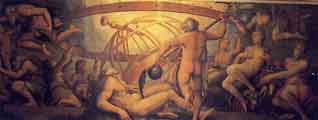
The Mutiliation of Uranus by Saturn, Vasari and Christofano 16th century

Saturn and Philyra, Parmigianino (Francesco Mazzola)
Cronus Devouring his Child, Giulia Lama
Saturn in a niche devouring his son, Giovanni Jacopo Caraglio
Minerva and Saturn Protecting Art and Science from Envy and Lies, Joachim von Sandrart
Saturn and Philyra, Giovanni Jacopo Caraglio
Saturn. Satue of the nude god standing on a socle, Philips Galle
Saturn in the guise of a horse being suckled by the nymph Philyra, Giulio Bonasone
References
See also : Greek Mythology. Paintings, Drawings
| Ancient Greece
Science, Technology , Medicine , Warfare, , Biographies , Life , Cities/Places/Maps , Arts , Literature , Philosophy ,Olympics, Mythology , History , Images Medieval Greece / Byzantine Empire Science, Technology, Arts, , Warfare , Literature, Biographies, Icons, History Modern Greece Cities, Islands, Regions, Fauna/Flora ,Biographies , History , Warfare, Science/Technology, Literature, Music , Arts , Film/Actors , Sport , Fashion --- |
Retrieved from "http://en.wikipedia.org"
All text is available under the terms of the GNU Free Documentation License


